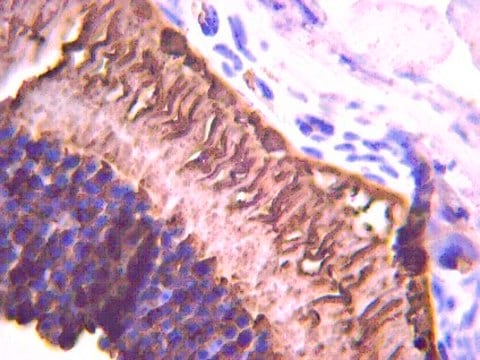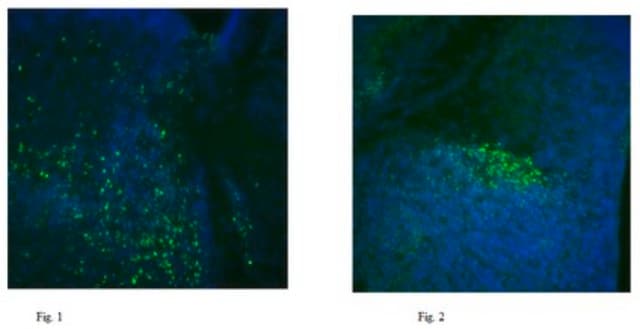AB5585
Anti-Recoverin Antibody
serum, Chemicon®
Synonim(y):
Recoverin
About This Item
Polecane produkty
pochodzenie biologiczne
rabbit
forma przeciwciała
serum
rodzaj przeciwciała
primary antibodies
klon
polyclonal
reaktywność gatunkowa
human, mouse, rat, frog, chicken
producent / nazwa handlowa
Chemicon®
metody
immunocytochemistry: suitable
immunohistochemistry (formalin-fixed, paraffin-embedded sections): suitable
western blot: suitable
numer dostępu NCBI
numer dostępu UniProt
Warunki transportu
dry ice
docelowa modyfikacja potranslacyjna
unmodified
informacje o genach
human ... RCVRN(5957)
mouse ... Rcvrn(19674)
Opis ogólny
Specyficzność
Immunogen
Zastosowanie
Neuroscience
Sensory & PNS
1:1,000-1:5,000 dilution using ECL.
Immunohistochemistry:
1:1,000 (2 hours at room temperature or overnight at 2-8ºC) on frozen and paraffin embedded tissue sections. Suggested fixative is 4% paraformaldehyde or 3% paraformaldehyde with 0.1% glutaraldehyde. Suggested permeabilization solution is 0.1% Triton X-100. Suggested blocking buffer is 0.05 M Tris saline, pH 7.4 containing 2.5% BSA, 0.1% triton and 0.05% sodium azide.
Optimal working dilutions must be determined by the end user.
Opis wartości docelowych
Powiązanie
Postać fizyczna
Przechowywanie i stabilność
Komentarz do analizy
POSITIVE CONTROL: Recoverin is found in photoreceptors and midget cone bipolar cells in retina and pinealocytes in pineal gland.
Inne uwagi
Informacje prawne
Oświadczenie o zrzeczeniu się odpowiedzialności
Not finding the right product?
Try our Narzędzie selektora produktów.
Kod klasy składowania
11 - Combustible Solids
Klasa zagrożenia wodnego (WGK)
WGK 1
Temperatura zapłonu (°F)
Not applicable
Temperatura zapłonu (°C)
Not applicable
Certyfikaty analizy (CoA)
Poszukaj Certyfikaty analizy (CoA), wpisując numer partii/serii produktów. Numery serii i partii można znaleźć na etykiecie produktu po słowach „seria” lub „partia”.
Masz już ten produkt?
Dokumenty związane z niedawno zakupionymi produktami zostały zamieszczone w Bibliotece dokumentów.
Nasz zespół naukowców ma doświadczenie we wszystkich obszarach badań, w tym w naukach przyrodniczych, materiałoznawstwie, syntezie chemicznej, chromatografii, analityce i wielu innych dziedzinach.
Skontaktuj się z zespołem ds. pomocy technicznej








